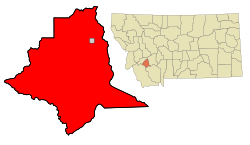Butte, Montana
| Butte-Silver Bow, Montana | ||
|---|---|---|
| Consolidated city-county | ||

Butte viewed from the campus of Montana Tech
|
||
|
||
| Nickname(s): Butte America | ||
| Motto: The Richest Hill on Earth | ||
 Location of Butte in Montana |
||
 Map of Silver Bow County showing Butte highlighted in grey |
||
| Coordinates: 45°59′56″N 112°31′27″W / 45.99889°N 112.52417°W | ||
| Country |
|
|
| State |
|
|
| County | Silver Bow | |
| Area | ||
| • Consolidated city-county | 716.8 sq mi (1,867.6 km2) | |
| • Land | 716.1 sq mi (1,854.7 km2) | |
| • Water | 0.7 sq mi (1.7 km2) | |
| Elevation | 5,538 ft (1,688 m) | |
| Population (2010) | ||
| • Consolidated city-county | 33,525 | |
| • Estimate (2015) | 33,922 | |
| • Metro | 34,680 | |
| Time zone | MST (UTC−7) | |
| • Summer (DST) | MDT (UTC−6) | |
| ZIP code | 59701, 59702, 59703, 59707, 59750 | |
| Area code(s) | 406 | |
| FIPS code | 30-11397 | |
| GNIS feature ID | 2409651 | |
| Website | http://co.silverbow.mt.us | |
Butte /ˈbjuːt/ is a city in, and the county seat of Silver Bow County, Montana, United States. In 1977, the city and county governments consolidated to form the sole entity of Butte-Silver Bow. As of the 2010 census, Butte's population was approximately 34,200. Butte is Montana's fifth largest city.
In the 19th and 20th centuries, Butte experienced every stage of development of a mining town, from camp to boomtown to mature city to center for historic preservation and environmental cleanup. Unlike most such towns, Butte's urban landscape includes mining operations set within residential areas, making the environmental consequences of the extraction economy all the more apparent. Despite the dominance of the Anaconda Company, Butte was never a company town. It prided itself on architectural diversity and a civic ethos of rough-and-tumble individualism. In the 21st century, efforts at interpreting and preserving Butte's heritage are addressing both the town's historical significance and the continuing importance of mining to its economy and culture.
Butte was one of the largest cities in the Rocky Mountains in the late 1800s and early 1900s. Silver Bow County (Butte and suburbs) had 24,000 people in 1890, and peaked at 100,000 in 1920. The population steadily declined with falling copper prices after World War I, eventually dropping to 34,000 in 1990 and stabilized. In 2013, the population remains at 34,200. In its heyday from the late 19th century to circa 1920, it was one of the largest and most notorious copper boomtowns in the American West, home to hundreds of saloons and a famous red-light district. The documentary Butte, America, depicts its history as a copper producer and the issues of labor unionism, economic rise and decline, and environmental degradation that resulted from the activity.
...
Wikipedia

